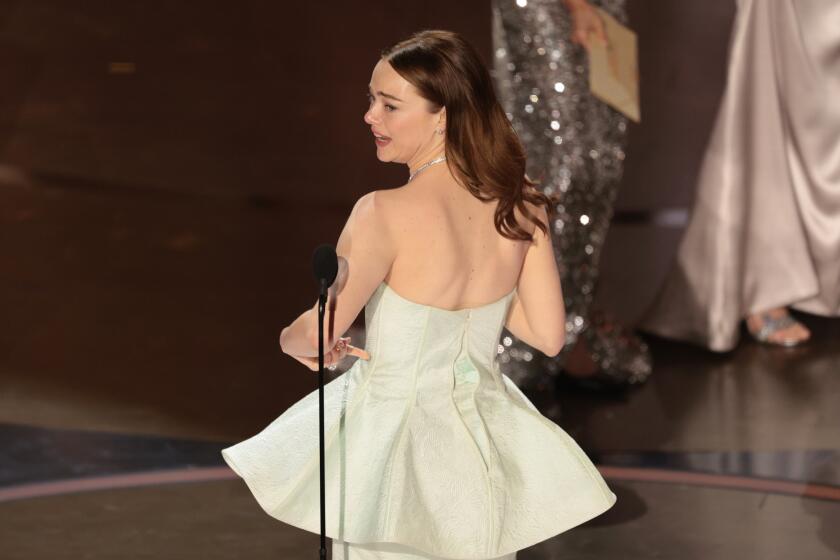Bidding farewell to Oscar auction
And the Oscar for best Hollywood courtroom drama goes to . . . the Academy of Motion Picture Arts and Sciences.
The golden statuette was awarded Monday by a Los Angeles Superior Court jury, which ruled that if Mary Pickford’s heirs want to sell it, they have to offer it to academy officials for $10 instead of auctioning it off for as much as $800,000.
Academy leaders took a Rancho Mirage woman, her daughter and a cousin to court after the women announced plans to sell the Oscar presented in 1930 to the silent-movie star known as “America’s sweetheart” and donate the proceeds to charity.
Marian Stahl, daughter Kim Boyer and Boyer’s cousin Virginia Casey are disposing of Pickford’s estate, which at one time filled the legendary Beverly Hills estate known as Pickfair.
Along with the best actress Oscar for 1929’s silent melodrama “Coquette,” the estate also includes an honorary Oscar bestowed upon her in 1976 and a third Oscar, the Jean Hersholt Humanitarian Award, presented to actor-bandleader Buddy Rogers in 1986.
Rogers married Pickford in 1937 after her divorce from actor Douglas Fairbanks. After Pickford’s death in 1979, Rogers married Beverly Rogers. He died in 1999 and she died in 2007, leaving the estate to Stahl, who is her sister, Boyer and Casey.
Jealously guarding the Oscar trademark, the film academy has since 1951 required recipients to sign an agreement giving the group the right of first refusal to buy back any unwanted Oscar for the token price of $10 (though that amount was later reduced to $1).
That has made pre-1951 Oscars a hot commodity. The best picture statuette for 1939’s “Gone With the Wind” was purchased for $1.54 million nine years ago by Michael Jackson. The best picture Oscar for 1941’s “How Green Was My Valley” sold for $95,000 four years ago.
Because Pickford signed the agreement when her honorary Oscar was presented to her and because she was a founder of the academy who remained a member until her death, academy officials contend that the 1930 Oscar was grandfathered into the rule on right of first refusal.
During an occasionally theatrical two-week downtown trial, an unidentified pair of 1930s-era Oscars were displayed to jurors, and a recent Pickfair estate auction catalog displaying hundreds of Pickford movie memorabilia items was brought to court.
The heirs sought to prove that the signature on the academy’s 1975 honorary Oscar agreement was not Pickford’s, who they suggested was too infirm to have signed it. The academy argued that she had her personal secretary, the late Esther Helm, sign her name for her.
Jurors only deliberated about an hour Monday before returning with their academy award on an 11-1 vote. Judge Joseph Kalin is expected to hear further arguments next Monday on equitable and legal issues not ruled on by the jury.
“We’re arguing that the receipt is an unenforceable agreement. The case is not over yet,” said Mark Passin, a lawyer for the heirs.
“The academy has tried to bury us in this litigation. The academy spent hundreds of thousands of dollars so the charities specified in Beverly Rogers’ will won’t receive any money. My clients are very upset. They pretty much spent their entire inheritance to fight the academy.”
Passin said Boyle had offered to donate the Oscar to the academy if the group would help find academy members willing to donate its worth to the Buddy Rogers Youth Symphony in the Coachella Valley. The 1930 Pickford statuette could have sold for $500,000 to $800,000 on the open market, he said.
David Quinto, a lawyer for the academy, said the organization on principle would never ask a member to donate money for the benefit of a third party attempting to flaunt current rules and sell an old Oscar.
“Every other heir out there would be saying, ‘What do you gimme for it?’ ” when disposing of a deceased Oscar winner’s property, he said.
Prior to the trial, the academy offered to make a direct charitable contribution of $50,000 if the heirs turned over Pickford’s 1930 statuette. Later, they increased the offer to $200,000 “only because Mary Pickford was a founder” of the academy, Quinto said Monday.
Word of the ruling was greeted glumly in the Coachella Valley. “It’s a shame money intended to help children has been squandered,” said Eric Frankson, a La Quinta musician involved with violin lessons for 332 students through the Buddy Rogers Youth Symphony.
Outside the courtroom, the melodrama continued, with Quinto suggesting the heirs would have spent proceeds from any statuette sale to cover their attorney costs. Not so, countered Passin.
All three Oscars from the Pickford-Rogers estate will permanently remain with the heirs, Passin said.
Or maybe not.
Quinto asserted that the academy is entitled to buy Pickford’s pair for a total of $20.
Passin shot back: “There was absolutely no ruling to that effect.”
As with every good courtroom drama, the plot thickens.
--
More to Read
Only good movies
Get the Indie Focus newsletter, Mark Olsen's weekly guide to the world of cinema.
You may occasionally receive promotional content from the Los Angeles Times.







